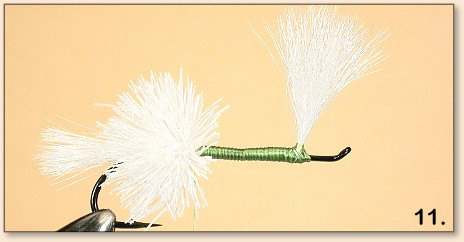
Bombers & Bugs |
|
 Bomber  Bug
Tail and wing materials. The original bomber had no wing(s) should we have one? Should it be a single or double wing, should it be upright or lay low as a snout! The models presented are double wings tied upright; this seems to be the most popular at our shop but not everywhere. This method allows the hook eye to be free and can be seen a little better in the water, there is very little or no difference to the fish. My personal preference (if I put one on) is the double wing tied low over the eye as a snout, this gives the fly a little better stability and floatability to the fly, similar to the original Whisker fly tied by Mr. Butterfield. I do take into consideration the materials I use because on our large river, one sometimes must cast a fair distance to reach the fish. I keep away from deer hair as I find it creates a lot of air resistance and prefer calf body hair and the more available calf tail.
Hackle What type and quality of hackle? I use saddle hackles no. 3 quality. Should the hackle be palmered towards the front or towards the rear? Should the hackle be pointing towards the rear (wet style) or towards the front (dry style) should one tie the hackle by the tip or the butt? I feel it doesn't make much of a difference with this fly which way the hackle is pointing or what direction you palmer it, as it is quite heavy and will very soon float on its body. What I do and why is as follows; I prefer tying my hackle by the tip at the rear of the fly, once I trim the body I tie my thread at the tail, tie on my hackle wrap the thread towards the head, at the tie off position, palmer my hackle towards the head and tie it off. You can palmer from front to back, tie on your hackle by the head, wrap your thread towards the tail, palmer the hackle rearward tie off the hackle cut the remaining stem, then wrap your thread through the hackle towards the head and whip finish amend. I face my hackle towards the rear, simply to reduce wind resistance (wet style) I also fold the hackle, it palmers easier through the deer hair, rather than sticking straight up never looks good to me that way, mind you the fish don't care. Tying by the tip or the butt? If you have a short hackle from a neck rather than a saddle you can tie it by the tip and palmer towards the head having the longer hackle fibers ending by the head. If you have a long saddle hackle with reasonably even length fibers you can tie it by the butt and palmer forward, I tie them all by the tip. How many wraps of hackle do I need? Size 4 hook six (6) will do, size 6 hook four (4) will do, just to keep the character of the fly, my customer's want at least ten (10) the fish can't count I think! More sometimes is not always better, but everyone has there preferences and that's great, the fish will take it anyway, I've fished them with the hackle broken and dragging behind and caught those elusive fish. What type and size of hook? I prefer a 3X long shank. The hook should be of light wire but strong, a good low water hook will do just fine, up or down eye hook makes no difference. How tight should the deer body hair be? Tie the clumps of deer hair at 90% thread strength so the body hair once tied will not turn easily as this will break the hackle. I do not press each clump of deer hair together very tight, it's better to have a loose body, it helps this fly float better, and everything helps. What thread should I use? 6/0 or 3/0 monocord should do the trick. How long should the tail and wing be? A small bunch of moderate length, no longer than the length of the body.
The basic construction |
Conventional Bombers tied by Marc Madore



|




|




|
Conventional Bugs tied by Marc Madore



|





|
 Bomber with all hackle body, tied by Marc Madore
 Bomber with herl & hackle body, tied by Marc Madore
Bugs with Dubbed Variations, tied by Marc Madore

|




|




|



|
*About Marc Madore
|
[ HOME ]
[ Search ] [ Contact FAOL ] [ Media Kit ]

















